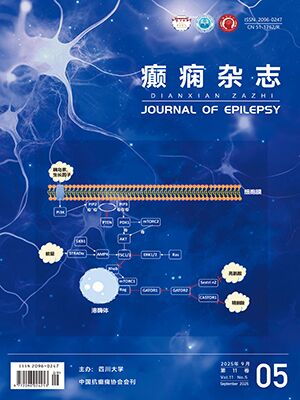| 1. |
Curatolo P, Bombardieri R, Jozwiak S. Tuberous sclerosis. Lancet, 2008, 372(128):657-668.
|
| 2. |
廖建湘.生酮饮食疗法的临床方案.中华实用儿科临床杂志, 2013, 28(12):881-883.
|
| 3. |
王纪文, 张娜娜.生酮饮食疗法的安全性.中华实用儿科临床杂志, 2013, 28(12):886-887.
|
| 4. |
Kossoff EH, Thiele EA, Pfeifer HH, et al. Tuberous sclerosis complex and the ketogenic diet. Epilepsia, 2005, 46(10):1684-1686.
|
| 5. |
Roach ES, Gomez MR, Northrup H. Tuberous sclerosis complex consensus conference:revised clinical diagnostic criteria. Child Neurol, 1998, 13(7):624-628.
|
| 6. |
Kossoff EH, Zupec Kania BA, Amark PE, et al. Optimal climical management of children receiving the ketogenicdiet:recommendations of the International Ketogenic Diet Study Group. Epilepsia, 2009, 50 (2):304-317.
|
| 7. |
Dhamija R, Eckea S. Ketogenic diet. Can J Neurol Sci, 2013, 40(2):158-167.
|
| 8. |
Suo C, Liao J, Lu X, et al. Efficacy and safety of the ketogenic diet in Chinese children. Seizure, 2013, 22(3):174-178.
|
| 9. |
Coppola G, Klepper J, Ammendola E, et al. The effects of the ketogenic diet in refractory partial seizures with reference to tuberous sclerosis. Euro J Paed Neurol, 2006, 10(3):148-151.
|
| 10. |
Ijff DM, Aldenkamp AP. Cognitive side-effects of antiepileptic drugs in children. Handb Clin Neurol, 2013, 111(36):707-718.
|
| 11. |
Eddy CM, Rickards HE, Cavanna AE. The cognitive impact of antiepileptic drugs. The Adv Neurol Disord, 2014, 4(2):385-407.
|
| 12. |
周水珍.生酮饮食治疗儿童难治性癫痫.中华实用儿科临床杂志, 2013, 28(2):883-885.
|
| 13. |
朱登纳, 谢蒙蒙, 王军, 等.生酮饮食添加治疗难治性癫痫36例.中国实用儿科临床杂志, 2014, 29(19):1483-1487.
|
| 14. |
Lambrechts DA, Bovens MJ, de la Parra NM, et al.Ketogenic diet effects on cognition, mood, and psychosocial adjustment in children. Acta Neurol Scand, 2013, 127(2):103-108.
|
| 15. |
Gha-hyun Lee, Bo-mi Kim, Joong Koo Kang, et al. Loss of the initial efficacy of levetiracetam in patients with refractory epilepsy. Seizure, 2013, 22(3):185-188.
|
| 16. |
Nabil J, AzarAndre H Lagrange, Lily Wang, et al. Transient improvement after brief antiepileptic drug withdrawal in the epilepsy monitoring unit-possible ralationship to AED tolerance. Epilepsia, 2010, 51(5):811-817.
|




